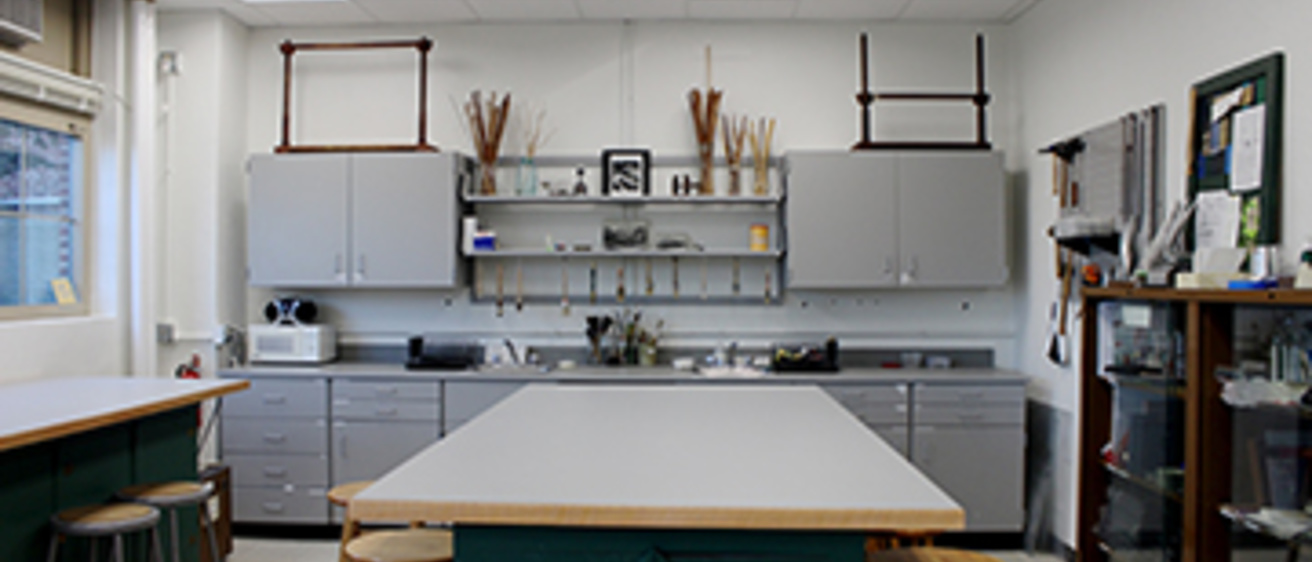
Breadcrumb
- Home
- Facilities
- Bookbinding
Binding
The Kolarik Book Studio is located in North Hall, along with our papermaking and print studios. Kolarik is a fully equipped bindery with open workspace in which binding and artist book classes are held. Equipment includes two board shears, several kutrimmers, guillotine, standing press, nipping presses, job backer, sewing frames, plough, foil stamper and drill press. The studio also includes a variety of hand tools and equipment such as Japanese screw punches, leather working tools, and cold metal working tools. In addition to Kolarik Book Studio, Center students also have access to Rooms 22 and 25, which serves as graduate student storage and work space and contain additional binding equipment. Center students also have access to the Historical Book Model collection (link is external) at the UI Libraries Conservation Lab (link is external). UI Libraries Special Collections (link is external) is another resource for both historical and artist's book structures.
The Center offers a variety of courses in bookbinding: for complete course descriptions, see the Center for the Book listing in the UI Catalog (link is external). For Center course availabilities, check listings at MYUI (link is external); enter "UICB" in the "Course Subject" field then click on "Search."
Courses
Elements of Book Art
Overview of book art process and techniques for nonmajors; introduction to traditional bookbinding skills, nontraditional book structures, and content development for artist books.
Bookbinding I
Hands-on introduction to materials and techniques commonly used in bookbinding.
Bookbinding II
Build on skills acquired in Bookbinding I; projects to complete six bindings based on historical and contemporary models; sewing styles, board attachments, endband types; nonadhesive and case-bound structures, varied materials and binding styles, their effects on structure, aesthetic considerations, further development of solid binding skills; historical development of particular binding practices.
Bookbinding III
Bookbinding structures based on historical and contemporary models; differences in various binding practices, how these differences affect function, why the styles developed; experience choosing appropriate structures for particular uses; emphasis on fine tuning skills and techniques required for advanced binding practices; sewn endbands, rounding and backing, sewing on varied supports, board attachments, and covering methods.
Bookbinding IV: Advanced Projects
Advanced studies in bookbinding; fine binding styles, leather paring and tooling, advanced finishing techniques, refining skills; continued look at differences in regional binding practices, how these differences affect function, and why particular styles developed.
Artists' Books
Exploration of the book as a form for artistic expression; emphasis on conceptual development; relationship between content, form, and structure; how a book's structure and design can enhance and integrate part of the work's meaning.
Historical Book Structures
Historical development of book structures examined through surviving examples, construction of historical models.
Boxes and Enclosures
Hands-on techniques for a variety of book enclosures; appropriateness, aesthetic issues concerning box design; Japanese wraparound case, drop-spine box, hinged and lidded boxes, slipcase; technical skill development.
Book Conservation
Practical methods, materials assessment, conservation history and evolution.